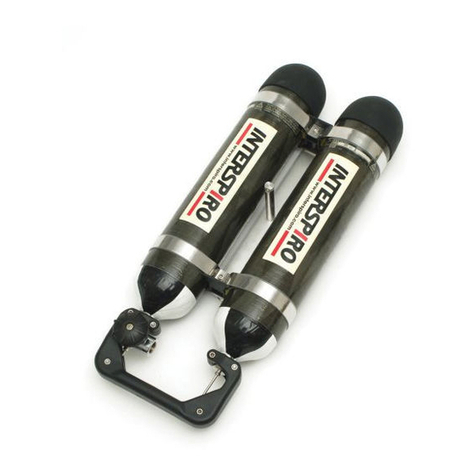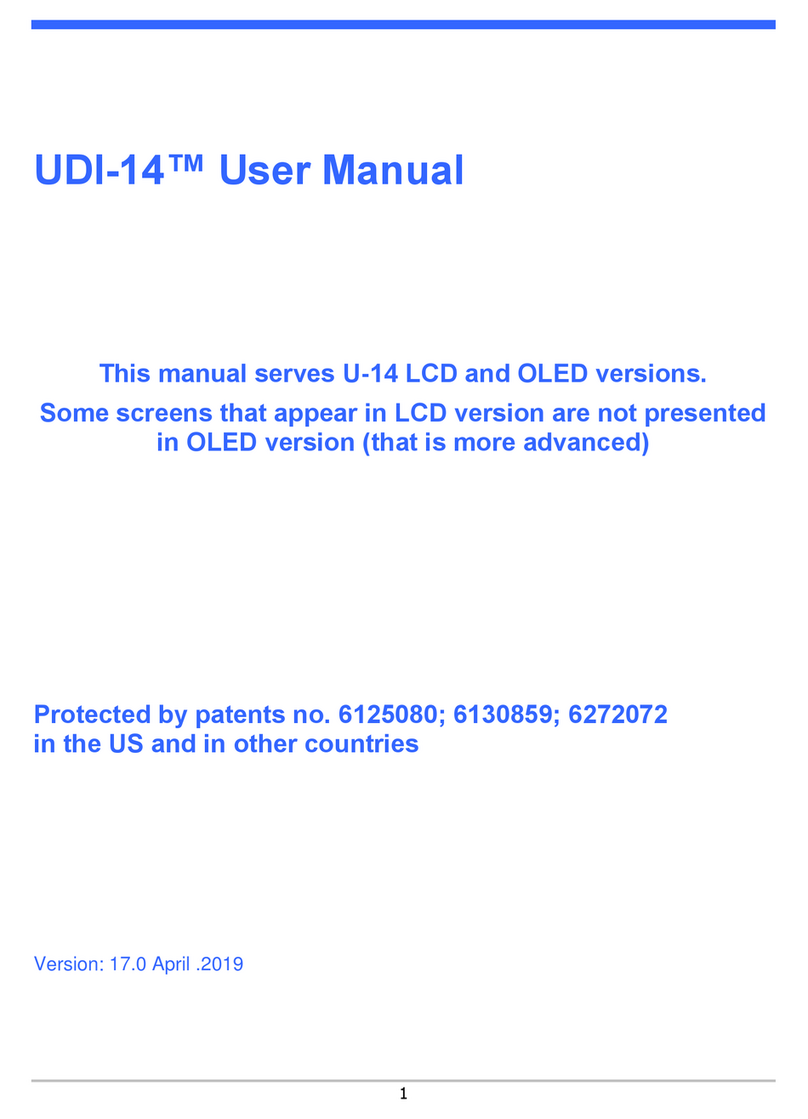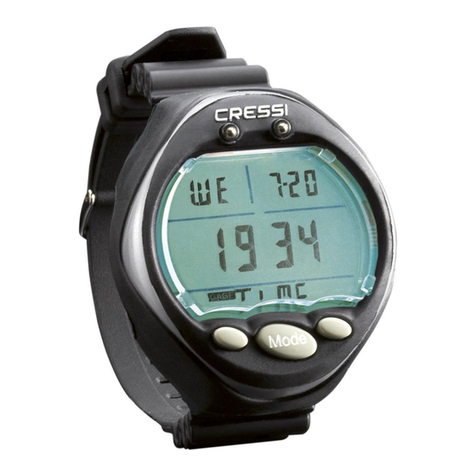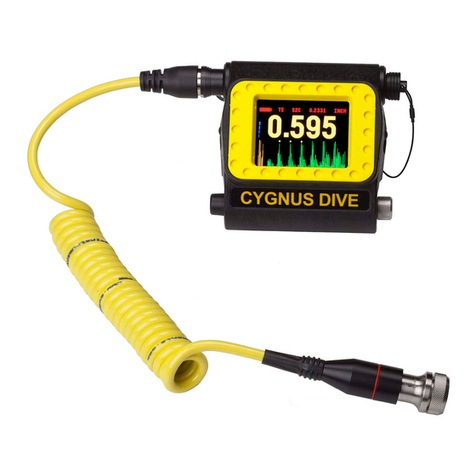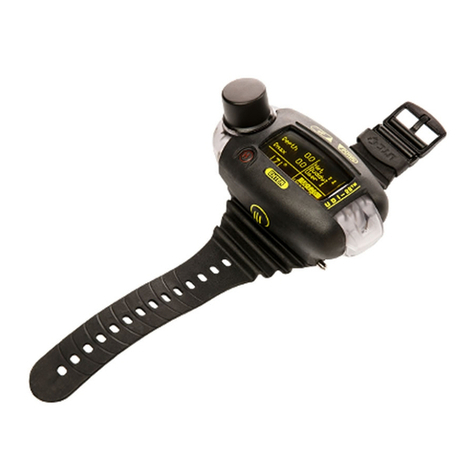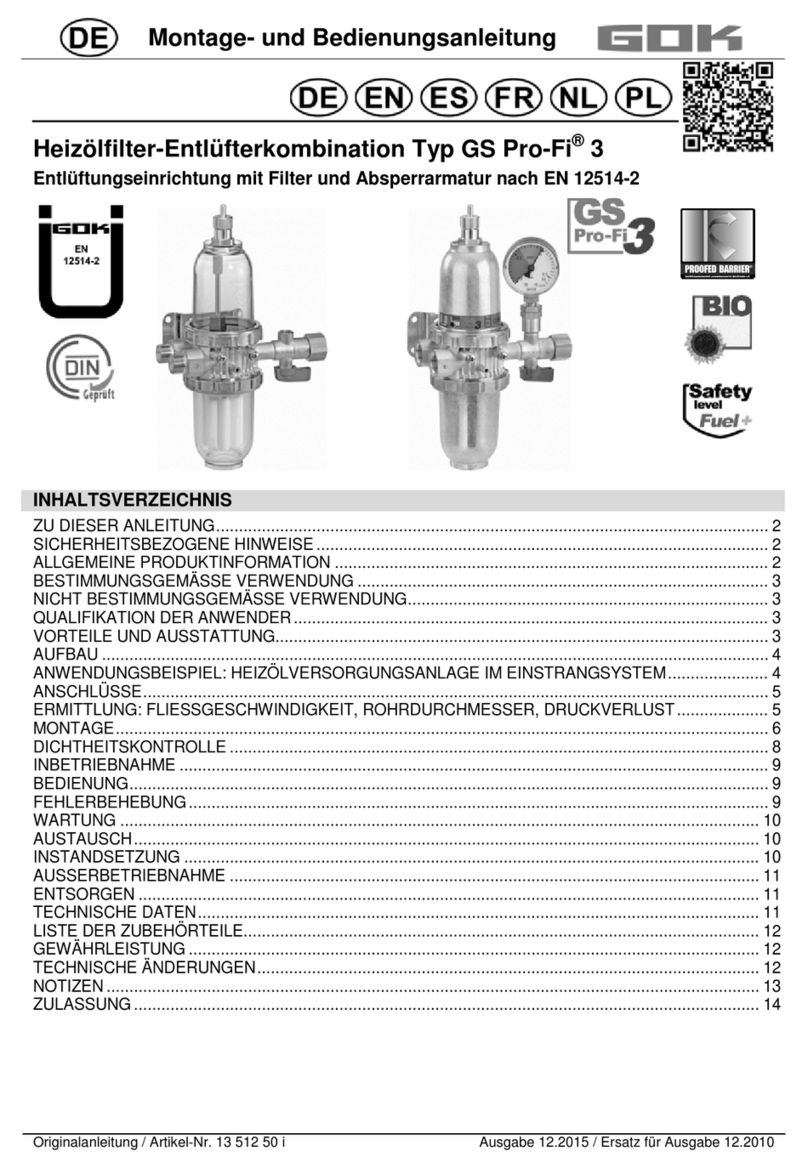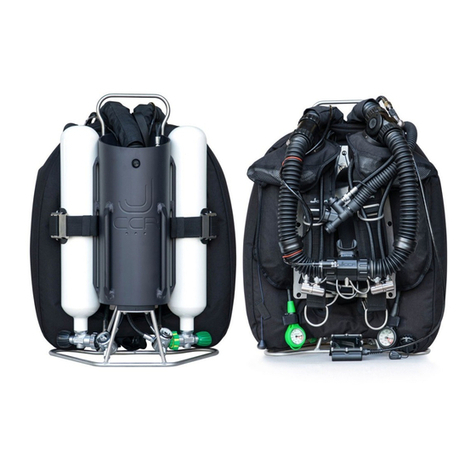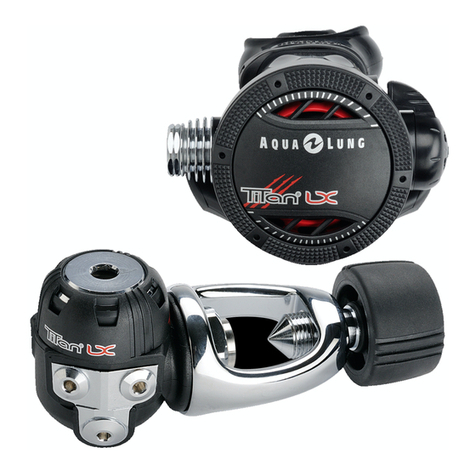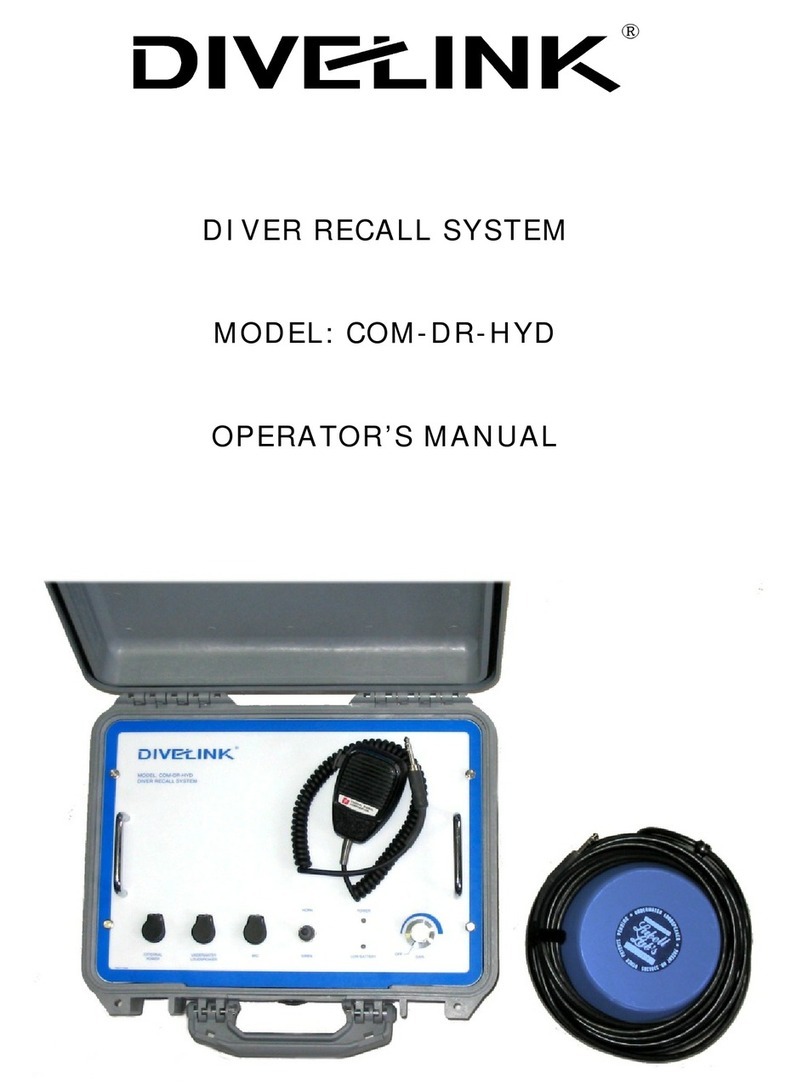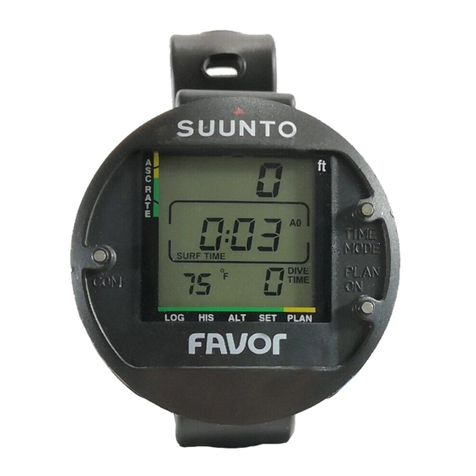Apeks XTX200 User manual

TECHNICAL SUPPORT
APEKS MARINE EQUIPMENT LTD, NEPTUNE WAY, BLACKBURN, LANCASHIRE. BB1 2BT
Document No. AP6209F
Issue 1
30/10/2013
XTX SECOND STAGE
REGULATOR
MAINTENANCE MANUAL
FOR
AUTHORISED TECHNICIANS

2
XTX Second Stage Regulator Maintenance Manual
Change
No.
Change
Request No.
Description & Comments: Change
Date
New Issue
No.
Changed
By:
Approved
By:
AMENDMENTS RECORD:
Amendments and approval of this document can only be carried out by the relevant people listed on the Approved list of
signatures, which is listed in the Apeks Quality Manual. To instigate a change, a Task / Change request form, (Form No.
‘DESI/10002’), must be completed and passed to the relevant person(s) for approval which are listed on the Approved List of
Signatures. When approval has been granted and recorded this table can then be completed and the document up issued.

3
XTX Second Stage Regulator Maintenance Manual
Contents
RANGE COVERED .................................................................................................................................................. 4
COPYRIGHT NOTICE............................................................................................................................................... 5
INTRODUCTION....................................................................................................................................................... 5
WARNINGS, CAUTIONS & NOTES......................................................................................................................... 5
SCHEDULED SERVICE ........................................................................................................................................... 5
GENERAL GUIDELINES .......................................................................................................................................... 5
GENERAL CONVENTIONS...................................................................................................................................... 6
DISASSEMBLY PROCEDURES............................................................................................................................... 6
REASSEMBLY PROCEDURES................................................................................................................................ 9
FINAL TESTING ..................................................................................................................................................... 14
CONVERTING THE XTX REGULATOR TO LEFT HANDED CONFIGURATION ................................................. 15
TABLE 1 - TROUBLESHOOTING GUIDE.............................................................................................................. 18
TABLE 2 - RECOMMENDED TOOL LIST.............................................................................................................. 19
TABLE 3 - RECOMMENDED LUBRICANTS AND CLEANERS........................................................................... 20
CLEANING AND LUBRICATION PROCEDURE.................................................................................................... 21
TABLE 4 -TORQUE SPECIFICATIONS ................................................................................................................. 22
TABLE 5 - TEST BENCH SPECIFICATIONS......................................................................................................... 22
XTX TUNGSTEN, XTX200, XTX100 EXPLODED PARTS DRAWING................................................................... 23
XTX50 EXPLODED PARTS DRAWING ................................................................................................................. 24
XTX40 & XTX20 EXPLODED PARTS DRAWING.................................................................................................. 25

4
XTX Second Stage Regulator Maintenance Manual
RANGE COVERED
This manual provides factory prescribed
procedures for the correct maintenance and repair
of the following Apeks XTX second stage regulator
range.
XTX200 / XTX100
Flagship model, features include: -
Adjustable cracking control
Integrated venturi control
Pneumatically balanced valve design
Spring Adjuster
Suitable for cold water use
Satin Chrome Finish (XTX100)
Bright Chrome Finish (XTX200)
Tungsten PVD Finish (XTX Tungsten)
Right or Left hand hose conguration
Diver Changeable Exhaust Tees (DCE)
New Hose Swivel connection (optional)
Metal Inserted front cover
XTX50
Features include: -
Adjustable cracking control
Integrated venturi control
Pneumatically balanced valve design
Spring Adjuster
Suitable for cold water use
Bright Chrome Finish
Right or Left hand hose conguration
Diver Changeable Exhaust Tees (DCE)
Two shot plastic front cover
XTX40
Features include: -
Integrated venturi control
Pneumatically balanced valve design
Suitable for cold water use
Bright Chrome Finish
Right or Left hand hose conguration
Diver Changeable Exhaust Tees (DCE)
Two shot plastic front cover
XTX20
Features include: -
Integrated venturi control
Pneumatically balanced valve design
Bright Chrome Finish
Right or Left hand hose conguration
Diver Changeable Exhaust Tees (DCE)
Two shot plastic front cover

5
XTX Second Stage Regulator Maintenance Manual
An Ofcial Inspection consists of:
1. A pressurised immersion test of the entire unit to
check for air leakage.
2. Checking for stable medium pressure that is within
the acceptable range.
3. Checking for opening effort that is within the
acceptable range.
4. Checking for smooth operation of the control knob
and venturi switch.
5. A visual inspection of any lters for debris or dis-
colouration.
6. A visual inspection of the exhaust valve(s) to see
that they are in good condition and that it is seating
against a clean and undamaged surface.
7. A visual inspection of the mouthpiece looking for
tears or holes and checking the general condition.
8. Pulling back hose protectors and checking that the
hoses are secure in the hose crimps.
If a regulator fails steps 1,2,3 or 4 the entire regulator
should be serviced. If a regulator fails 5,6 or 7 it will be up
to the technician’s discretion whether or not a full service
is required. Failure of step 8 requires replacement of the
Hose.
GENERAL GUIDELINES
1. In order to correctly perform the procedures outlined
in this manual, it is important to follow each step
exactly in the order given. Read over the entire
manual to become familiar with all procedures and
to learn which specialty tools and replacement parts
will be required before commencing disassembly.
Keep the manual open beside you for reference while
performing each procedure. Do not rely on memory.
2. All service and repair should be carried out in a work
area specically set up and equipped for the task.
Adequate lighting, cleanliness, and easy access to all
required tools are essential for an efcient repair facil-
ity.
3. During disassembly, reusable components should be
segregated and not allowed to intermix with non-
reusable parts or parts from other units. Delicate
parts, including inlet ttings and valve seats which
contain critical sealing surfaces, must be protected
and isolated from other parts to prevent damage
during the cleaning procedure.
4. Use only genuine Apeks parts provided in the 2nd
stage service kit (AP0219). DO NOT attempt to
substitute an Apeks part with another manufacturer’s,
regardless of any similarity in shape or size.
5. Do not attempt to reuse mandatory replacement
parts under any circumstances, regardless of the
amount of use the product has received since it was
manufactured or last serviced.
6. When reassembling, it is important to follow every
torque specication prescribed in this manual,
using a calibrated torque wrench. Most parts are
made of either marine brass or plastic, and can be
permanently damaged by undue stress.
COPYRIGHT NOTICE
This manual is copyrighted, all rights reserved. It may not,
in whole or in part, be copied, photocopied, reproduced,
translated, or reduced to any electronic medium or machine
readable form without prior consent in writing from Apeks
Marine Equipment Ltd. It may not be distributed through the
internet or computer bulletin board systems without prior
consent from Apeks Marine Equipment Ltd.
©2006 Apeks Marine Equipment Ltd.
XTX Second Stage Maintenance Manual
(AP6209F Issue 1)
INTRODUCTION
This manual provides factory prescribed procedures for the
correct maintenance and repair of the Apeks XTX second
stage regulator range. It is not intended to be used as an
instructional manual for untrained personnel. The procedures
outlined within this manual are to be performed only by
personnel who have received factory authorised training
through an Apeks Service & Repair Seminar. If you do not
completely understand all of the procedures outlined in this
manual, contact Apeks to speak directly with a Technical
Advisor before proceeding any further.
WARNINGS, CAUTIONS & NOTES
Pay special attention to information provided in warnings,
cautions, and notes that are accompanied by one of these
symbols:
WARNINGS indicate a procedure or situation
that may result in serious injury or death if
instructions are not followed correctly.
CAUTIONS indicate any situation or technique
that will result in potential damage to the
product, or render the product unsafe if
instructions are not followed correctly.
NOTES are used to emphasise important points,
tips, and reminders.
SCHEDULED SERVICE
It is recommended that the Apeks XTX second stage regulator
should be serviced annually regardless of usage.
However, If at all unsure about the correct functioning of the
Apeks XTX, then it must be ofcially inspected immediately.
All service and inspection details need to be documented
in the Regulator Service Record in the back of the Owner’s
Manual to keep the Limited Lifetime Warranty in effect.

6
XTX Second Stage Regulator Maintenance Manual
Pinch Method
Press upwards
on sides of ‘O’
Ring to create a
protrusion. Grab
‘O’ Ring or insert
‘O’ Ring tool at
protrusion.
NOTE: Ensure that the tool is rmly pressed
against the Case Cover whilst unscrewing.
Removal of hose
Removal of diaphragm
GENERAL CONVENTIONS
Unless otherwise instructed, the following terminology and
techniques are assumed:
1. When instructed to remove, unscrew, or loosen a
threaded part, turn the part anti-clockwise.
2. When instructed to install, screw in, or tighten a
threaded part, turn the part clockwise.
3. When instructed to remove an ‘O’ Ring, use the pinch
method (see gure below) if possible, or use a brass,
aluminium or plastic ‘O’ Ring removal tool. Avoid using
hardened steel picks, as they may damage ‘O’ Ring
sealing surfaces. All ‘O’ Rings that are removed are
discarded and replaced with brand new ‘O’ Rings.
4. The following acronyms are used throughout the
manual: MP is Medium Pressure; HP is High Pressure;
PN is Part Number.
5. Numbers in parentheses reference the key numbers
on the exploded parts schematics. For example, in the
statement, “...remove ‘O’ Ring (11) from...”, the number
11 is the key number to the Blanking Piece ‘O’ Ring.
DISASSEMBLY PROCEDURES
NOTE: Before performing any disassembly,
refer to the exploded parts drawing, which refer-
ences all mandatory replacement parts. These
parts should be replaced with new, and must not
be reused under any circumstances - regardless
of the age of the regulator or how much use it
has received since it was last serviced.
CAUTION: Use only a plastic, brass or
aluminium ‘O’ Ring removal tool (PN AT79)
when removing ‘O’ Rings to prevent damage
to the sealing surface. Even a small scratch
across an ‘O’ Ring sealing surface could
result in leakage. Once an ‘O’ Ring sealing
surface has been damaged, the part must
be replaced with new. DO NOT use a dental
pick, or any other steel instrument.
1. Using two 11/16” spanners, hold the Heat Exchanger
(6) stationary while turning the Hose Swivel anticlockwise.
Remove the ‘O’ Ring from inside the Hose
Swivel. Exercise caution not to scratch the ‘O’ Ring
groove. Remove the ‘O’ Ring from the male end of the
Hose.
2. Pull back the two
Hose Protectors and
inspect the Hose
Crimps. If either
Crimp is damaged or
the Hose is pulling
out of the crimp then
the Hose must be
replaced.
3. Using the Apeks XTX Tool (PN AT20F), unscrew the
Case Cover (2).
NOTE: The Front Cover (2) and Purge Button (1)
should be cleaned complete. It is not necessary to
remove the purge button when servicing.

7
XTX Second Stage Regulator Maintenance Manual
Removal of valve assembly
NOTE: The Venturi Lever may have come out
with the valve Spindle in step 6. If this is the case,
depress the Lever and slide the Venturi Lever off
from right to left.
4. Lift out the Diaphragm Cover (3) and Diaphragm (4).
Inspect the Diaphragm. It should be supple and be
free from damage. If it looks good, there is no need to
replace it and it may be reused. If there is any sign of
deterioration, it should be replaced.
5. Using an 11/16”
spanner, remove the
Heat Exchanger (6).
6. Turn the Adjusting Screw (30) anti-clockwise until it
stops. For the XTX40 and XTX20 models use an Allen
key to turn the Adjusting Screw (37). Press the Lever
(20) against the Valve Spindle (18). While keeping the
Lever depressed, grasp the Knob and pull the Valve
Spindle assembly out of the Case (24). Remove the
Blanking Piece (8) from the opposite side of the case.
7. Remove the two ‘O’ Rings (7) & (9) from the
Blanking Piece (8).
8. Grasp the Venturi Lever (13 + 14) and pull it out of the
Case (24). Remove the ‘O’ Ring (9) from the Venturi
Lever.
9. It is NOT necessary to separate the Venturi Lever
into its two separate parts unless the regulator is
being converted to a different hand conguration. To
separate them grasp the Venturi Lever (13 + 14) as
shown below and push the Venturi Ring (13) off the
Venturi Lever Body (14).
10. Turn the Adjusting
Screw (30) or
(37) for XTX40/20
clockwise (inward)
one turn. The Spring
Pin (19) should
drop out. If the Pin
remains in the Valve
Spindle, use a 1/16”
dowel or punch to
push it partially out,
then use needle nose
pliers to completely
remove it from the
valve body.
11. Unscrew the Adjusting Screw (30) or (37) for XTX40/20
and completely remove it from the Valve Spindle (18).

8
XTX Second Stage Regulator Maintenance Manual
12. Remove the ‘O’ Ring (31) from the Adjusting
Screw.
Remove the Plug (26) from the Adjusting Screw. Using
an Allen key, unscrew the Spring Adjuster (27) and
press the spring adjuster out. Remove the two ‘O’
rings (28 & 29) from the Spring Adjuster.
13. Remove the ‘O’ Ring (7) from the Valve Spindle.
14. Insert a small 1/8” wooden dowel into the threaded
end of the Valve Spindle and push out the Shuttle
Valve assembly (32-36). Separate the Shuttle Valve
assembly by pulling on each end.
15. Using a ngernail, remove the Rubber Seating (36)
and small ‘O’ Ring (34) from the Shuttle Valve.
16. Using a Slotted Seat Adjuster (PN AT51), turn the Seat
(15) six to seven full turns anti-clockwise. Since the
Seat is ‘O’ Ring sealed, it will not completely unscrew
from the Valve Spindle. Insert a pair of external
circlip pliers into the Valve Spindle, and pull the Seat
completely out. Remove the ‘O’ Ring (16) from the
Seat.
17. To remove the Spindle Collar (17), push both edges of
the collar as shown below.
NOTE: It is not necessary to remove the Spindle
Collar under normal servicing circumstances,
unless it is deemed relevant by the service
technician, for example if it is damaged or dirty.
18. The Lever (20) should be inspected for deterioration, it
is NOT necessary to remove it from the Valve Spindle.
If the Lever is to be removed, carefully pull one of
the legs out of the Valve Spindle and then ease the
second leg out.

9
XTX Second Stage Regulator Maintenance Manual
REASSEMBLY PROCEDURES
Fitting Exhaust Valve and Exhaust Tees
WARNING: Flooding may occur if the tail of
the valve is not fully pulled through. Check
that barb has engaged on inside of Case.
This Ends Disassembly
Before starting reassembly, perform parts
cleaning and lubrication according to the
procedures outlined in ‘Cleaning & Lubrication’
on page 21.
NOTE: If the Exhaust Valve (25) is to be
removed, pinch edge of Exhaust Valve and pull
tail through hole in Case (24).
Inspection and Removal of Exhaust Valve
Removal of mouthpiece
19. To remove the Exhaust Tees (21) & (23), depress the
retaining button located in the centre (see picture) and
slide the Left Hand Exhaust Tee (21) off the Case (24).
Then Slide the Right Hand Exhaust Tee (23) off the
case.
20. Fold back the edges of the Exhaust Valve (25) and
inspect underneath. The seating surface should be
clean and free of damage. Inspect the Exhaust Valve.
It should be supple and have well dened edges.
If it looks good, there is no need to remove it and it
may be reused. If there is any sign of deterioration, it
should be replaced.
21. Using side cutters,
snip the Mouthpiece
Clip (11) taking
care not to damage
the Mouthpiece
(12). Remove the
Mouthpiece (12).
1. If the Exhaust Valve (25) was removed, replace by
threading the tail through the retaining hole on the
outside of the Case (24) until the barb engages on the
inside. If the Exhaust Valve is new, cut off the excess
stem with side cutters leaving approximately 5mm of
the tail behind.
2. Check that the
Exhaust Rib (22)
is rmly located in
the Left Hand Large
Exhaust Tee (21).
3. Align the Left Hand Exhaust Tee (21) guide with the slots
on the Case (24). Slide the Exhaust Tee onto the Case
until the retaining button is positioned centrally over
the Exhaust Valve (25). Align the Right Hand Exhaust
Tee (23) with the Case and slide into position, until the
retaining button clips underneath the Left Hand Exhaust
Tee (21).

10
XTX Second Stage Regulator Maintenance Manual
Assembling and tting valve assembly
NOTE: Ensure Rubber Seating has been tted
ush with Shuttle Valve.
CAUTION: Ensure that Lever is not twisted
and that legs are parallel. Lever should
appear as that shown on the left, not as
shown on the right. If necessary, gently
squeeze legs together to straighten.
WARNING: Ensure that the spindle collar is
set in the correct position. Failure to do so
will result in a substantial loss of breathing
performance.
CAUTION: Ensure that the Spindle Collar
clicks rmly into position and that the entire
Valve Spindle Hole is visible.
4. Install a new,
lubricated ‘O’ Ring
(7) onto the Valve
Spindle. (18).
5. Press a new, lubricated ‘O’ Ring (34) onto the stem of
the Shuttle Valve (35). Press a new Rubber Seating
(29) into the front of the Shuttle Valve.
6. Fit the Valve Spring (33) onto the leading edge of the
Counterbalance Cylinder (32). Carefully guide the
stem of the Shuttle Valve through the Spring and into
the Counterbalance Cylinder.
7. If the Spindle Collar (17) was removed during the
disassembly process replace the Spindle Collar (17)
using a set of circlip pliers. Spread the Collar and push
it onto the Valve Spindle. Ensure that the arrow points
towards the lever.
CAUTION: Do not overstretch the Spindle
Collar when replacing doing so may cause
the Spindle collar to crack and break.
8. If you removed the Lever (20), position the Valve
Spindle (18) so that the Lever Hole is to the left of the
centre line and the Dimple is to the right of the centre
line with the threaded end facing you. (See photo
below left). Insert the lever so that it points to the right
of the Valve Spindle, as shown below.
9. Ensure that the Spindle Collar is rotated to the correct
position for the required Hose conguration.

11
XTX Second Stage Regulator Maintenance Manual
NOTE: The Arrow and line must be aligned to
ensure that the two parts fasten together correctly.
Ensure that the correct conguration of regulator
is selected. I.e. if the Regulator is to be congured
as Right Handed, then the arrow must be aligned
to the line with RIGHT underneath. See the sec-
tion titled Converting the XTX Regulator to Left
Handed Conguration on page 15 for further
information.
CAUTION: Ensure that the parts of the
Venturi Lever are rmly pressed together.
There should be a step as shown in the
photo on the right above. An audible click
should be heard when pressing together.
NOTE: Ensure that the Lever has a full range
of movement and does not catch on the Valve
Spindle. Ensure that the spring can be seen
through the Valve Spindle Hole.
10. With the “feet” of the Shuttle Valve pointing
downward (away from the Lever) and the Lever
pointing straight up (perpendicular to the Valve
Spindle), insert the Valve assembly into the Valve
Spindle. Using your nger, press the Shuttle Valve
assembly all the way into the Valve Spindle.
11. Install a new, lubricated ‘O’ Ring (31) onto the
Adjusting Screw (30) or (37) for XTX40/20. Install new,
lubricated ‘O’ Rings (29 & 28) onto the Spring Adjuster
(38). Using an Allen key, thread the Spring Adjuster into
the Adjusting Screw (30) until it is ush with the end of
the screw, then screw in six full additional revolutions.
12. Install the Adjusting Screw into the Valve Spindle.
There should now be spring tension on the Lever.
Continue to screw clockwise until the holes for the
Spring Pin are clear. Install the Spring Pin (19). Be
sure that it sits evenly in the hole. Back the Adjusting
Screw out anti-clockwise to apply tension on the Pin to
keep it from falling out.
13. If the Venturi Lever was separated slide the Venturi
Ring (13) onto the Venturi Lever Body (14). Align the
Arrow on the Venturi Ring with the line on the Venturi
Lever Body above the RIGHT text. Press the Venturi
Ring rmly onto the end of the Venturi Lever Body,
until it clicks into place.

12
XTX Second Stage Regulator Maintenance Manual
CAUTION: Ensure that the Lever is vertical
after tightening.
CAUTION: Excessive
tightening of the
Heat Exchanger will
damage the Blanking
Piece and Case.
14. Install a new, lubricated ‘O’ Ring (9) onto the Ven-
turi
Lever (13 & 14). Point the Venturi Lever upward and
insert it into the Case (24) marked RIGHT
15. Install a new, lubricated ‘O’ Ring (9) onto the Blanking
Piece (8). Point the Blanking Piece upward and insert
it into the Case. Press it against the Case so the ‘O’
ring is captured.
16. While depressing the Lever, insert the Valve Spindle
through the Venturi Lever and into the Case. Be sure
that the two ats and the two Lever feet engage in the
tabs of the Blanking Piece.
17. Slide a new, lubricated ‘O’ Ring (7) down the threaded
end of the Valve Spindle. Screw the Heat Exchanger
(6), hexagon facing outward, onto the Valve Spindle
until nger tight. Using an 11/16” crows foot or deep
socket, tighten to a torque of 3 Nm (2.2Ibf / ft).
18. Fit a new, lubricated ‘O’ Ring (16) onto the Seat (15).
Press the Seat, threaded end rst, into the Valve
Spindle. Using the Slotted Seat Adjuster Tool, push the
Seat into the Valve Spindle as far as it will go.

13
XTX Second Stage Regulator Maintenance Manual
CAUTION: Ensure Diaphragm is seated
correctly and not creased.
Fitting Diaphragm
Fitting Hose and Mouthpiece
WARNING: Ensure that the Mouthpiece is
properly secured on the outlet port.
Before tting hose, carry out suction test by
holding thumb over Valve Spindle (20) to seal and
trying to breathe through mouthpiece outlet port.
No air should be drawn in.
19. While holding the rim of the case at eye level, turn
the seat in clockwise until the lever drops about 4mm
below the case rim.
20. Position the Diaphragm (4) into the Case (24).
Using your nger, work the edges of the Diaphragm
into place so it sits evenly in the Case. Install
the Diaphragm Cover (3) into the Case, over the
Diaphragm.
21. Screw the Case Cover onto the Case. Using the
XTX Tool (p/n AT20F) tighten the Cover until it stops.
Conrm that the Purge Button is properly aligned.
22. Add a new lubricated ‘O’ Ring (AP1409) to the male end
of the Hose. Install a new, lubricated ‘O’ Ring (AP1154)
into hose swivel end.
23. Screw the Hose onto the second stage. Using an
11/16” crows-foot and torque wrench and a spanner on
the Heat Exchanger, tighten the Hose to 5 Nm.
24. If equipped with a Comfo-bite Mouthpiece, make sure
the ‘bridge’ of the Mouthpiece (12) is facing upward.
Stretch the Mouthpiece over the second-stage Mouthpiece
outlet port. At the base of the Mouthpiece is a
groove for the Mouthpiece Clip Wrap the Clip around the
Mouthpiece so that the buckle points toward the Hose.
Tighten the Clip and snip the excess with side cutters.
NOTE: If your facility is equipped with a test bench,
perform the tests before installing the mouthpiece.
General instructions for performing bench tests are
located in the next section “Final Testing.”
25. After all testing has
been completed, ret
the Plug (26) (If tted)
into the Adjusting
Screw (30).

14
XTX Second Stage Regulator Maintenance Manual
6. Disconnect the second stage from the hose as shown
in step 1 of the disassembly procedure. Using the
Slotted Seat Adjuster Tool (PN AT51) ,turn the seat
(15) anti- clockwise by approximately 1/16 of a turn
(see step 14 of reassembly procedures for Ref.
Repeat both step 3 and step 5. As a nal check now
tap the purge button as in Step 2 causing freeow,
stopping this by placing hand over mouthpiece.
Second Stage Opening Effort Test
1. Connect the rst stage regulator to a calibrated test
bench and pressurise the system to 200 (±10) bar.
Slowly open the owmeter control knob (start vacuum)
while watching both the magnahelic gauge and the
intermediate pressure gauge.
2. When the intermediate pressure begins to drop,
indicating the second-stage valve is open, the
magnahelic gauge should indicate an opening effort
of +1.0 in.H2O (2.5mbar) to +1.5 in.H2O (3.7mbar). If
the reading is outside of these specications, adjust
the micro Adjuster (38), turning anti-clockwise to lower
the opening effort or clockwise to increase the opening
effort. If this fails to give the correct reading refer to
“Table 1 - Troubleshooting” for corrective actions.
External Leak Test
1. After disconnecting the regulator from the ow bench,
connect it to a gas cylinder lled to approximately 200
bar. Open the cylinder valve to repressurise the regu-
lator, and submerge the entire system in a test tank of
clean water.
2. Observe any bubbles arising from the submerged
regulator over a one minute period. The
recommended time is necessary due to slower bubble
formation that occurs in smaller leaks. Bubbles
indicate a leak, which requires the system to be
disassembled at the source to check sealing surfaces,
assembly sequence and component positioning in
order to correct the problem(s).
NOTE: Extremely small leaks may be better
detected by applying a soap solution or Snoop™
to the leak area. Bubble streams will indicate the
source of the leak. Before disassembling to correct
any leaks, rinse the entire regulator thoroughly with
fresh water and blow out all residual moisture with
ltered, low-pressure air. Disassemble and remedy
the problem, referring to “Table 1 - Troubleshooting.”
Subjective Breathing Test
1. Depress the Purge Button fully to ensure that an
adequate volume of air needed to clear the second
stage ows through the mouthpiece. Then, inhale
slowly but deeply from the mouthpiece. A properly
serviced and adjusted regulator should deliver air upon
deep inhalation without excessive inhalation effort,
freeow, or “uttering” of the second-stage diaphragm.
When exhaling, there should be no uttering or
sticking of the exhalation valve. If any of these
problems occur, refer to “Table 1 - Troubleshooting”.
NOTE: If the Spindle Collar (17) is not correctly
positioned, the regulator will not freeow. The the
hole in the Valve Spindle (18) should also face the
top of the Case (24). Disassemble and remedy the
problem, referring to steps 7 to 9 of the reassembly
procedure.
FINAL TESTING
WARNING: Compressed air can be highly
explosive and is dangerous if misused. Ensure
cylinder valve is opened slowly. Use eye and ear
personal protective equipment when performing
any tests involving compressed air.
Setting the Lever Height
1. Connect the rst stage regulator to a calibrated test bench
and pressurise the system to 200 (±10) bar. Make sure
that the Adjuster Knob (35) is fully wound out and that the
Venturi Lever (13-14) is set to the “+” position.
2. Place the NO GAS FLOW side
of the XTX Tool (PN AT20F)
onto the purge button. (1).
Depress the Purge button by
pushing the tool in until it stops
against the Front cover. If no
gas ows from the second
stage proceed to step 4. If gas
ows from the valve follow step
3.
3. Disconnect the second stage
from the hose as shown in step
1 of the disassembly procedure,
(excluding ‘O’ Ring removal).
Using the Slotted Seat Adjuster
Tool (PN AT51), turn the seat
(18) clockwise by approximately
1/16 of a turn (see step 16
of the disassembly procedure
for Ref.). This lowers the lever
inside. Repeat step 2.
4. Place the GAS FLOW side of the
XTX Tool (above right) onto the
purge button(1) as positioned
before. Press the Purge in until it
stops against the Front cover. If
gas ows from the second stage
the lever height inside is correct.
However, if no gas ows from the
valve this means that the lever is
now set too low. Proceed to step
6.
5. Tap the purge button quickly, this should cause the regulator
to freeow. Stop the freeow after a couple of seconds by
placing a hand over the mouthpiece.
NOTE: It is important to ensure that the rim of the
tool is concentric with the rim of the purge button
throughout. Pressing on the logo with the tool mis-
aligned will not measure the purge button (depth of
pressing) and therefore, sensitivity, correctly.
This Ends Reassembly
NO GAS FLOW
GAS FLOW

15
XTX Second Stage Regulator Maintenance Manual
1. Using two 11/16” spanners, hold the Heat Exchanger
(6) stationary while turning the Hose Swivel anti-
clockwise.
CONVERTING THE XTX
REGULATOR TO LEFT HANDED
CONFIGURATION
2. Using the Apeks XTX Tool (PN AT20F), unscrew the
Case Cover (2). Lift out the Diaphragm Cover (3) and
Diaphragm (4).
NOTE: Ensure that the tool is rmly pressed against
the Case Cover whilst unscrewing.
3. Using an 11/16” spanner, remove the Heat Exchanger
(8).
4. Turn the Adjusting Screw (30) anti-clockwise until it
stops. For the XTX40 and XTX20 models use an Allen
key to turn the Adjusting Screw (37). Press the Lever
(20) against the Valve Spindle (18). While keeping the
Lever depressed, grasp the Knob and pull the Valve
Spindle assembly out of the Case (24). Remove the
Blanking Piece (8) from the opposite side of the case.
6. Grasp the Venturi Lever (13 + 14) and pull it out of the
Case. Remove the ‘O’ Ring (11) from the Venturi Lever.
NOTE: The Venturi Lever may have come out with
the valve Spindle in step 4. If this is the case, depress
the Lever and slide the Venturi Lever off from right to
left.
5. Remove the two ‘O’ Rings (9) & (7) from the Blanking
Piece (10).
7. Grasp the Venturi Lever (13 + 14) as shown below
and push the Venturi Ring (13) to separate it from the
Venturi Lever Body (17).
Right Handed Conguration Left Handed Conguration

16
XTX Second Stage Regulator Maintenance Manual
8. Rotate the Venturi Ring (13) on the Venturi Lever Body
(14). Grease the Venturi Lever body as shown. Align
the Arrow on the Venturi Ring with the line on the
Venturi Lever Body above the LEFT text. Press the
Venturi Ring rmly onto the end of the Venturi Lever
Body, until it clicks into place.
9. Install a lubricated ‘O’ Ring (9) onto the Venturi Lever
(13 + 14). Point the Venturi Lever upward and insert
it into the side of the Case marked ‘Left’ . Press it
against the Case so the ‘O’ Ring is captured.
NOTE: The Arrow and line must be aligned to ensure
that the two parts fasten together correctly. Ensure that
the correct conguration of regulator is selected. I.e.
if the Regulator is to be congured as Left Handed,
then the arrow must be aligned to the line with LEFT
underneath.
CAUTION: Ensure that the parts of the
Venturi Lever are rmly pressed together.
There should be a step as shown in the
photo on the right above. An audible click
should be heard when pressing together.
10. Install lubricated ‘O’ Ring (9) onto the Blanking Piece
(10). Point the Blanking Piece upward and insert it into
the Case. Press it against the Case so the ‘O’ Ring is
captured.
11. Rotate the Spindle Collar (17) on the Valve Spindle
(18) until it clicks into position. The Valve Spindle
should look like the photo on the right.
WARNING: Ensure that the spindle collar is
set in the correct position. Failure to do so
will result in a substantial loss of breathing
performance. The photo below shows the
Valve Spindle in both the Left and Right hand
congurations.
CAUTION: Ensure that the Spindle Collar
clicks rmly into position and that the entire
Valve Spindle Hole is visable.

17
XTX Second Stage Regulator Maintenance Manual
15. Using an 11/16” crows foot or deep socket, tighten to a
torque of 5 Nm.
CAUTION: Ensure that the Lever is vertical
after tightening.
CAUTION: Ensure Diaphragm is seated
correctly and not creased.
16. Position the Diaphragm (4) into the Case (24).
Using your nger, work the edges of the Diaphragm
into place so it sits evenly in the Case . Install
the Diaphragm Cover (3) into the Case, over the
Diaphragm.
Before tting hose, carry out suction test by
holding thumb over Valve Spindle (18) to seal and
trying to breathe through mouthpiece outlet port.
No air should be drawn in.
17. Screw the Case Cover (2) onto the Case. Using the
XTX Tool (p/n AT20F) tighten the Cover until it stops.
Conrm that the Purge Button is properly aligned.
18. Screw the Hose onto the second stage. Using an
11/16” crows-foot and torque wrench and a spanner on
the Heat Exchanger, tighten the Hose to 5 Nm.
This Ends the conversion procedure, proceed to
Final Testing
12. While depressing the Lever, insert the Valve Spindle
through the Venturi Lever and into the Case. Be sure
that the two ats and the two Lever feet engage in the
tabs of the Blanking Piece.
13. Slide a lubricated ‘O’ Ring (7) down the threaded end
of the Valve Spindle. Screw the Heat Exchanger (6),
hexagon facing outward, onto the Valve Spindle until
nger tight. Using an 11/16” crows foot or deep socket,
tighten to a torque of 3 Nm.
14. Ensure the Valve Spindle hole points to the top of the
case.
NOTE: If your facility is equipped with a test bench,
remove the mouthpiece as described on page 8.
General instructions for performing bench tests are
located in the section, “Final Testing” on page 14.

18
XTX Second Stage Regulator Maintenance Manual
Table 1 - Troubleshooting Guide
SYMPTOM POSSIBLE CAUSE TREATMENT
Leakage or freeow from XTX
Second Stage
1. Excessively high rst-stage intermediate
pressure.
1. Refer to rst-stage
Troubleshooting Guide.
2. Rubber Seating (36) damaged or worn. 2. Replace Rubber Seating.
3. Seat (15) adjusted incorrectly, Lever (23)
set too high.
3. Reset Seat preliminary
settings, and repeat Adjustment
Procedures.
4. Lever (20) bent. 4. Replace Lever.
5. Seat (15) sealing surface damaged. 5. Replace Valve Seat.
6. Valve Spring (33) damaged. 6. Replace Spring.
7. Shuttle Valve ‘O’ Ring (34) damaged. 7. Replace ‘O’ Ring.
8. Counter Balance Cylinder (32) bore dam-
aged.
8. Replace Counter Balance
cylinder.
9. Venturi Lever ‘O’ Ring (9) damaged. 9. Replace ‘O’ Ring.
Low purge or excessive work of
breathing (full cylinder)
1. Low rst-stage intermediate pressure. 1. Refer to rst-stage
Troubleshooting Guide.
2. Seat (15) adjusted incorrectly, Lever (20)
set too low.
2. Reset Seat preliminary
settings, and repeat Adjustment
Procedures.
3. Intermediate pressure hose clogged or
obstructed. 3. Clean or replace Hose.
4. Lever (20) bent or catching on Valve
Spindle (18). 4. Replace Lever.
5. Spindle Collar (17) incorrectly positioned
on Valve Spindle (18).
5. Rotate Spindle Collar to correct
position.
Water entering XTX Second Stage
1. Mouthpiece (12) damaged or incorrectly
tted.
1. Replace or re-t Mouthpiece as
appropriate.
2. Diaphragm (4) damaged. 2. Replace Diaphragm.
3. Diaphragm (4) improperly seated in Case
(25).
3. Remove Front Cover (4) and
Diaphragm Cover (5) properly
reassemble Diaphragm (check
for distortion).
4. Exhaust Valve (25) damaged. 4. Replace Exhaust Valve.
5. Case (24) damaged. (Check exhaust
valve seating surface.) 5. Disassemble and replace Case.
6. Heat exchanger ‘O’ Ring (7) damaged. 6. Replace ‘O’ Ring.
7. Venturi Lever or Blanking Piece ‘O’ Ring
(9) damaged. 7. Replace ‘O’ Ring.

19
XTX Second Stage Regulator Maintenance Manual
Table 2 - Recommended Tool List
PART NO. DESCRIPTION APPLICATION
AP0430 I.P. test gauge Intermediate pressure testing
AT79 ‘O’ Ring removal pick ‘O’ Ring removal
AT20F Front Cover Tool Case Cover removal and installation / Setting of Lever
Height
AT51 Slotted Seat Adjuster Removal and installation of Seat
n/a Torque wrench, Nm or lbf/ft Hose and Heat Exchanger
n/a 11/16” adapter for torque wrench Hose and Heat Exchanger
AT34 11/16” spanner 2 off Heat Exchanger
AT37 5mm Allen key Removal and installation of Micro Adjuster
n/a Side cutters Zip Tie, Exhaust Valve
AT38 6mm Allen key Removal and installation of Adjuster Screw
AT24 Internal Circlip Pliers Removal of Seat

20
XTX Second Stage Regulator Maintenance Manual
Table 3 - Recommended Lubricants & Cleaners
LUBRICANT / CLEANER APPLICATION SOURCE
Christo-Lube® MCG-111
(Lubricant)
All ‘O’ Ring seals Apeks Marine Equipment Ltd
PN AP1495, or
Lubrication Technologies
310 Morton Street
Jackson, OH 45640, USA
(800) 477-8704
PerFluoroLube® 20/1 (Lubricant) All ‘O’ Ring seals Lubrication Technologies
310 Morton Street
Jackson
OH 45640, USA
(800) 477-8704
Biox
(Cleaning agent)
Biological immersion uid for reusable stain-
less steel and brass parts.
Solent Divers Ltd
122-128 Lake Rd, Portsmouth,
Hants, PO1 4HH
White distilled vinegar (100 gr.)
(Cleaning agent)
Acid bath for reusable stainless steel and
brass parts.
“Household” grade
Liquid dishwashing detergent di-
luted with warm water
(Cleaning agent)
Degreaser for brass and stainless steel
parts; general cleaning solution for plastic
and rubber
“Household” grade
CAUTION: Silicone rubber requires no lubrication or preservative treatment. DO NOT
apply grease or spray to silicone rubber parts (eg. Diaphragm, Exhaust Valves.) Doing
so may cause a chemical breakdown and premature deterioration of the material.
CAUTION: Do not use muriatic acid for the cleaning of any parts. Even if strongly diluted,
muriatic acid can harm chrome plating and may leave a residue that is harmful to ‘O’
Ring seals and other parts
This manual suits for next models
4
Table of contents
Other Apeks Diving Instrument manuals
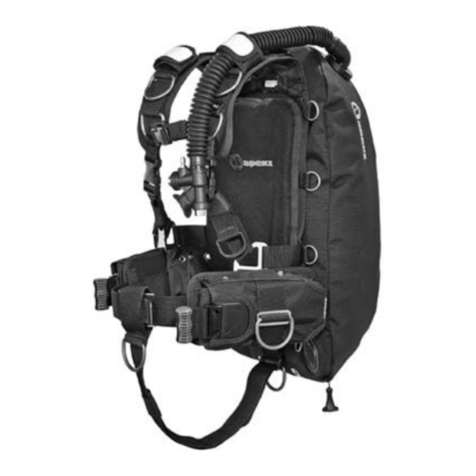
Apeks
Apeks WTX-D User manual
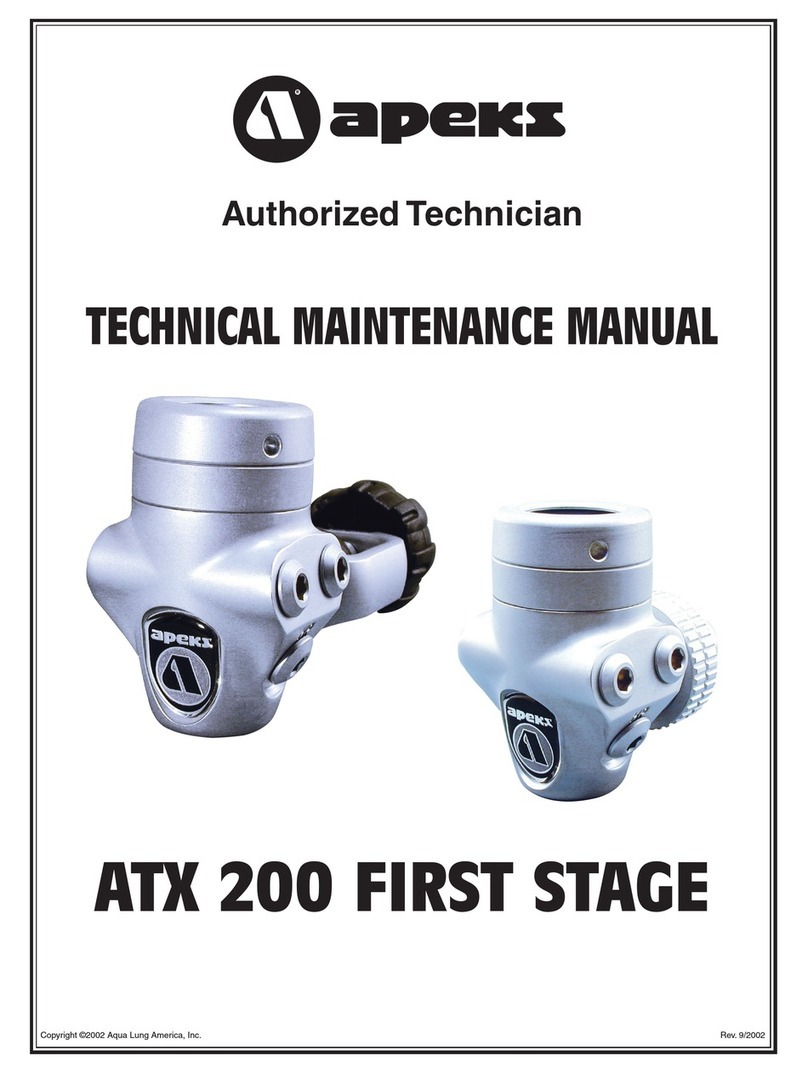
Apeks
Apeks ATX 200 User manual
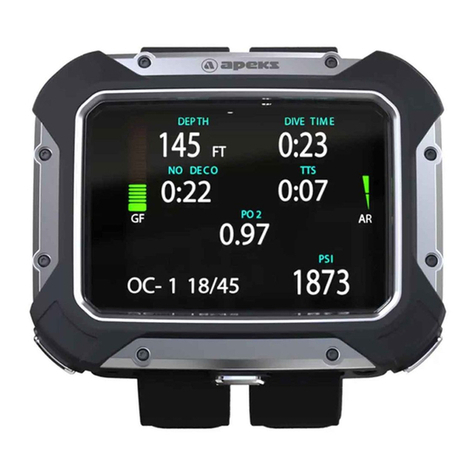
Apeks
Apeks NS158000 User manual
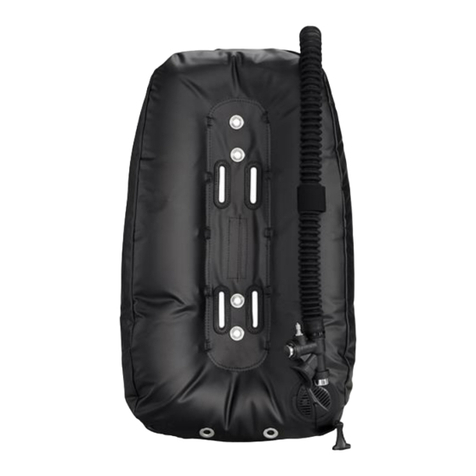
Apeks
Apeks wtx series User manual
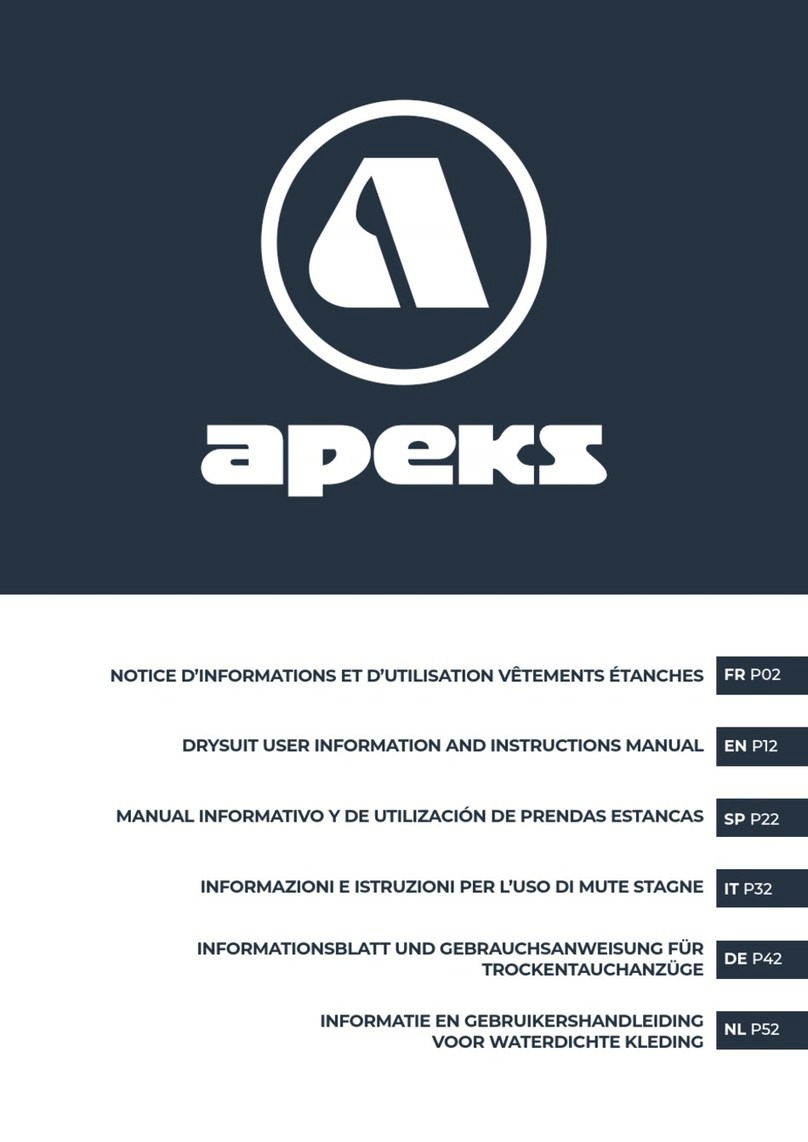
Apeks
Apeks ThermiQ Dry Advanced User manual
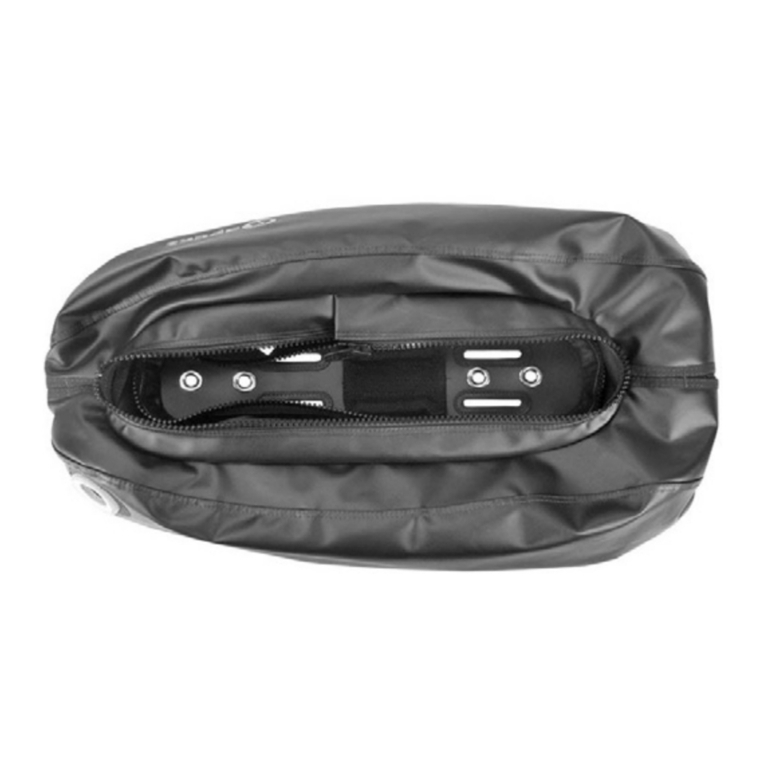
Apeks
Apeks wtx series User manual
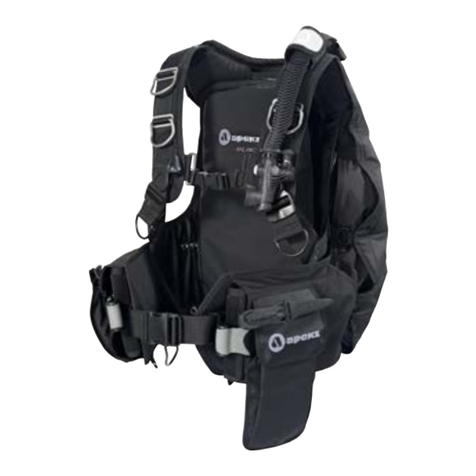
Apeks
Apeks Black Ice User manual
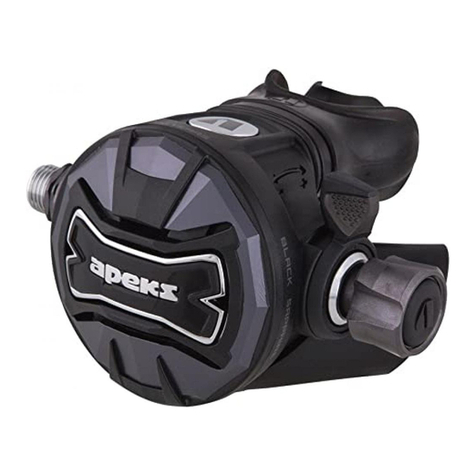
Apeks
Apeks BLACK SAPPHIRE User manual
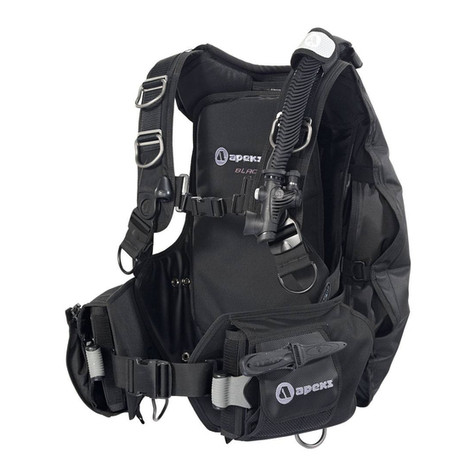
Apeks
Apeks Black Ice Twin Cylinder Kit User manual
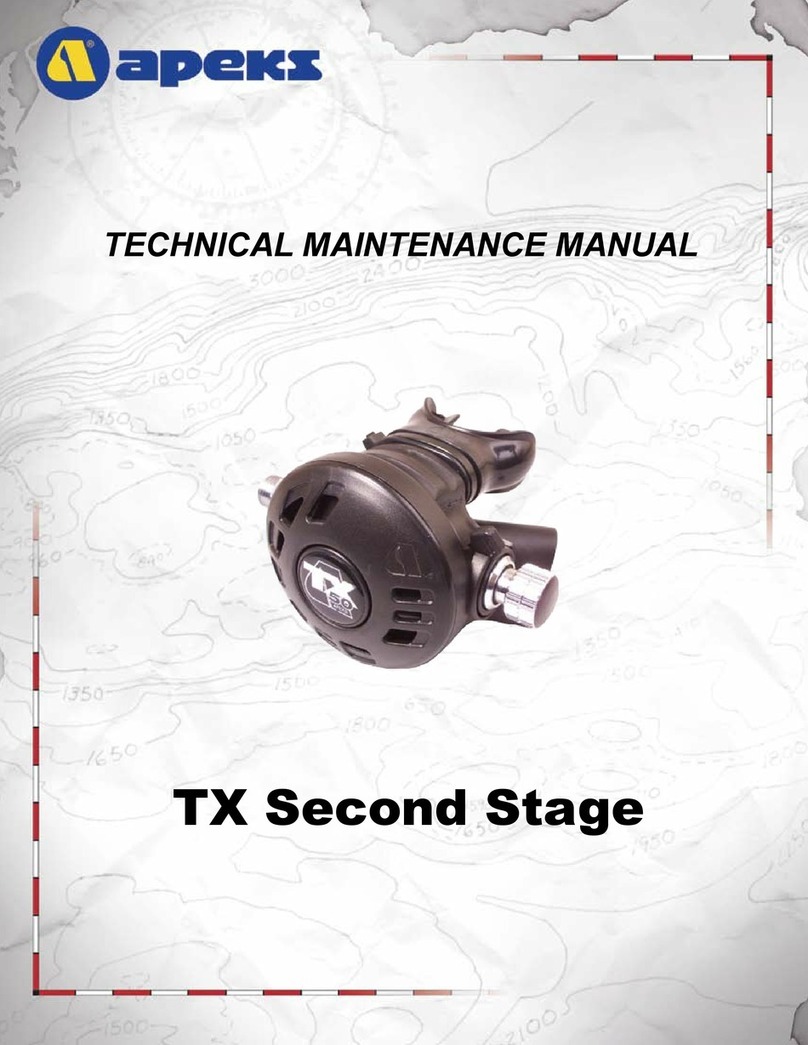
Apeks
Apeks TX Series User manual
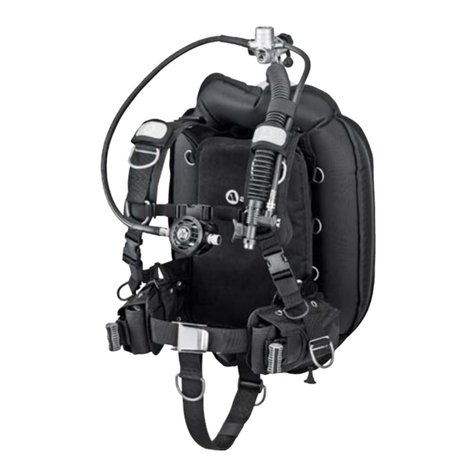
Apeks
Apeks WTX User manual

Apeks
Apeks wtx series User manual
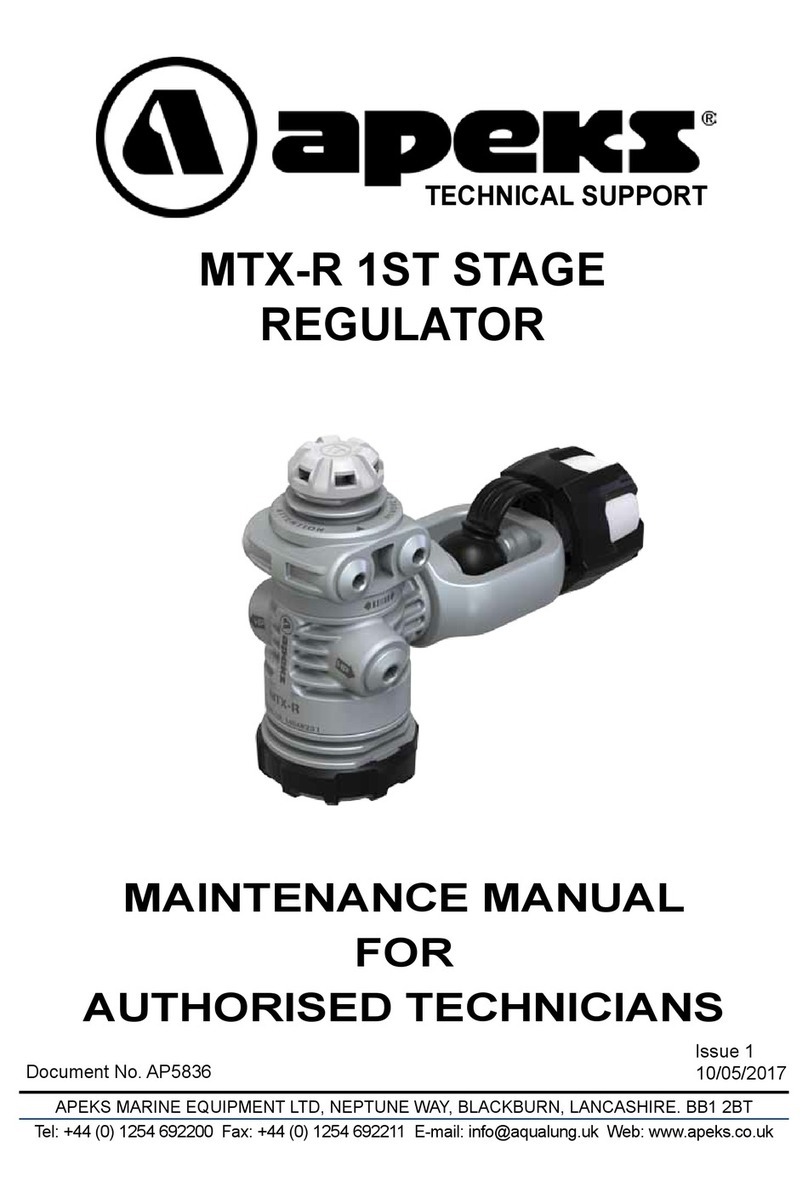
Apeks
Apeks MTX-R User manual

Apeks
Apeks 427106 User manual
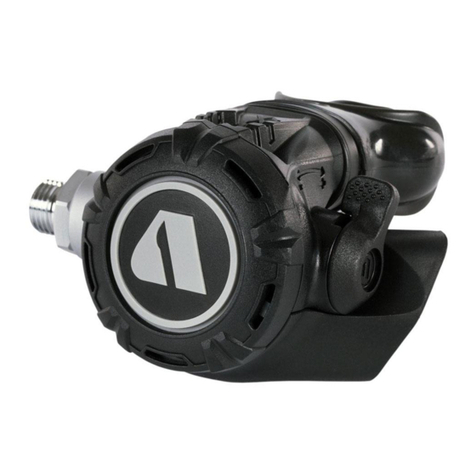
Apeks
Apeks XL4 SECOND STAGE User manual
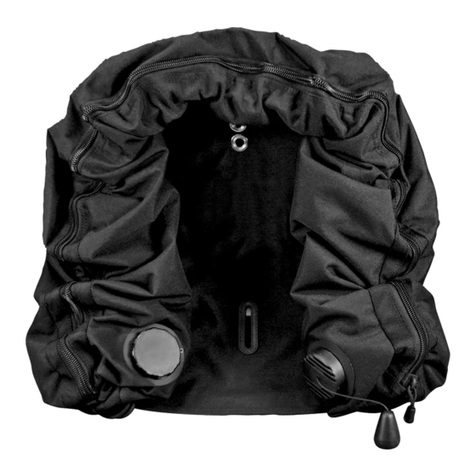
Apeks
Apeks 388300 User manual
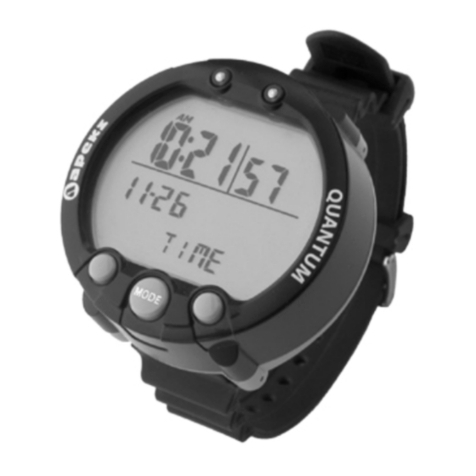
Apeks
Apeks Quantum User manual
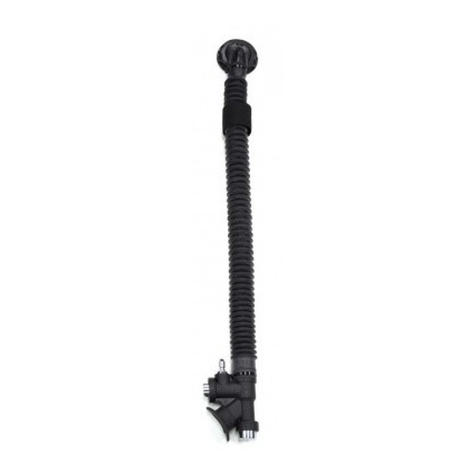
Apeks
Apeks WTX INFLATOR User manual
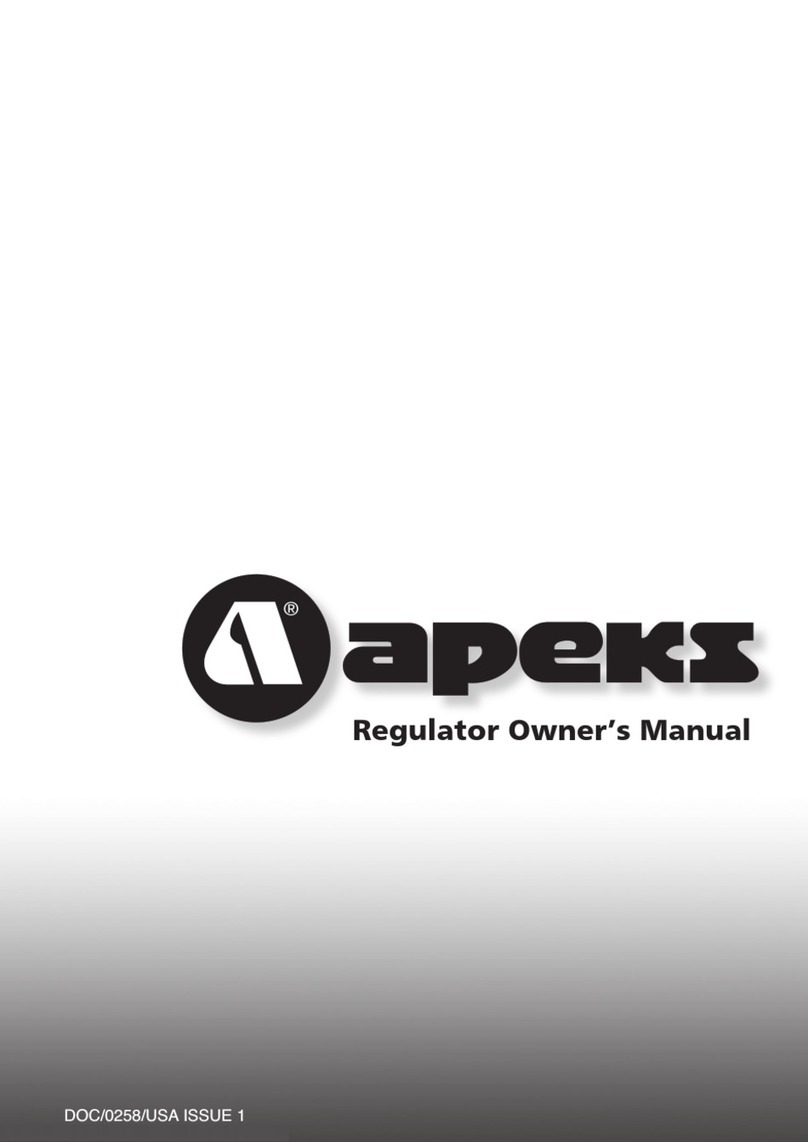
Apeks
Apeks Regulator User manual
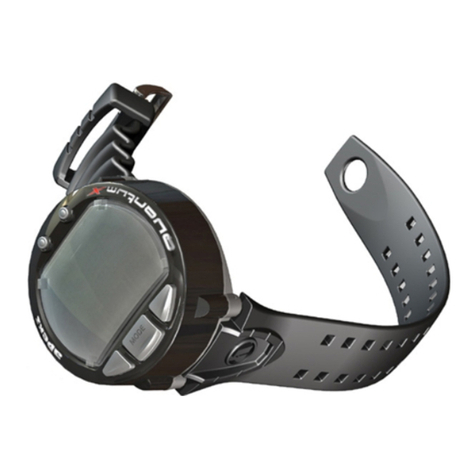
Apeks
Apeks QuantumX User manual

